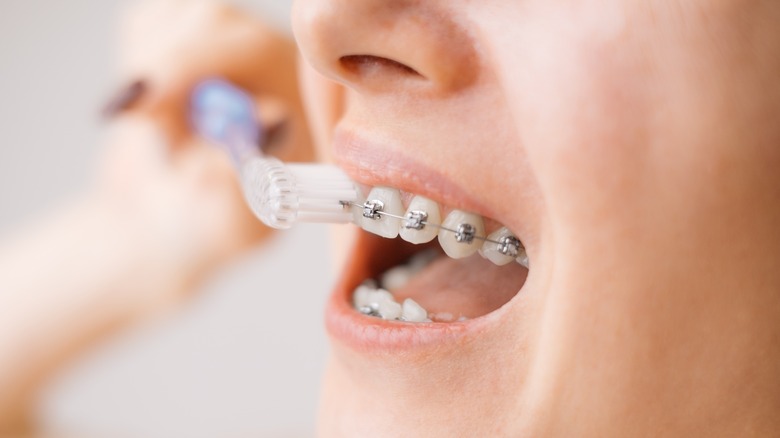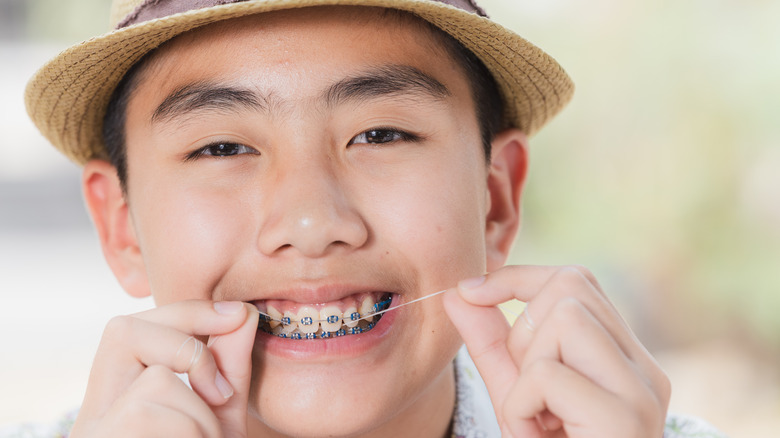How To Practice Good Oral Hygiene When You Have Braces
Nowadays, braces are typically seen as an adolescent rite of passage, but they aren't limited to this age group. According to a Tennessee-based dental practice, Snodgrass-King, the number of adults with braces has shot to over one million and continues to rise. That being said, a whopping 70% of teenagers around the world use them as well, as per Kennel Orthodontics.
The point of braces is to correct a multitude of dental issues, such as overcrowding and misaligned teeth, explains WebMD. They can also help correct over and underbites, bringing the jaw into a more aligned state. While the traditional braces are made of metal and include brackets and wires connected to each tooth, technology has evolved to include other forms of braces. You may also get to choose from ceramic braces, lingual braces (which are placed behind your teeth), and invisible braces, made of a clear plastic tray specially designed to fit onto your upper and lower teeth.
Proper oral hygiene is even more important when braces are added into the mix, especially considering that gum disease affects almost half of the U.S. population over 30 years old, as per the Centers for Disease Control and Prevention (CDC). Fortunately, there are many ways you can keep plaque and oral diseases at bay when wearing braces.
Good oral hygiene starts with the toothbrush
Nationwide Children's points out that the first step to ensuring your mouth, teeth, and gums stay healthy while using braces is to make sure you engage in proper toothbrushing habits. This includes buying a toothbrush either specifically designed for braces users or one that features a small brush head and bristles made of soft nylon.
When possible, opt for a toothpaste with fluoride, which prevents the teeth from undergoing a process known as demineralization, explains Medical News Today. This erodes the teeth, leading to cavities and other diseases. Fluoride also prevents plaque from building up around your teeth and gums.
Aside from a good toothbrush and toothpaste, you also need to clean your teeth in a specific way, especially if you wear braces. Nationwide Children's advises brushing your teeth no less than five times a day and shooting for a total brushing time of five minutes at each session. When cleaning, ensure to navigate the head of the brush into every nook and cranny of your teeth and gums using circular motions. Be sure to brush around and in between each bracket. Last but not least, don't forget to give your tongue a good scrubbing.
Oral hygiene isn't complete without floss
If you haven't already made flossing a regular part of your oral hygiene routine, you'll definitely need to do so now that you have braces. Healthline explains that floss helps you clean between the teeth, which is an area not properly accessed by a toothbrush alone, to prevent gum disease and tooth decay. Luckily, there's a variety of floss options to choose from to carry out this task. This includes traditional wax-covered thread, an oral irrigator, which uses a stream of water to clean between the teeth, or a floss threader.
Premier Orthodontics advises using the floss threader for the best overall clean. This tool consists of a thin material set in a loop that brings to mind the shape and purpose of a needle. You will then take a normal piece of floss and thread it through the loop of the tool. With the pointed end of the floss threader, you'll pass it through each tooth, making sure to get under the wire and between each bracket. Once you pull the threaded floss through, it will be as if you're flossing like normal.
Floss threaders are inexpensive and reusable, which makes them highly beneficial for several people. The only downside may be a bit of a learning curve. Luckily, there are videos to help guide you if you get stuck.



